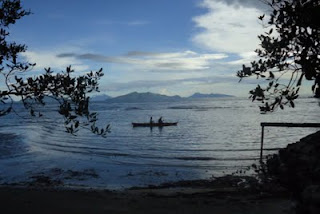
A flat-bottomed boat along a Calbayog mangrove.
(Or, sticking up for the disappearing habitat, and the culture that is born out of it. This is an attempt at a sort of mangrove "series".)
Mangroves, or trees that grow in intertidal (foreshore) areas, are a thing of beauty. They jut out of the water with amazing root structures. Because our country has one of the longest coastlines in the world, our beaches should be lined with either mangrove areas, marshes, or rocky surfaces to take yoga pictures on. Note that I did not mention white sand beaches, which are few and far in between in "nature" (more on that later).

Mangrove babies growing in a Biri Island restoration area.
But mangrove areas are not sexy. While they provide waste treatment (they are known as the "kidneys of the earth"), flood protection, and shielding from waves and wind, they are also a tricky habitat for moderns. The water is murky, and there are many living things in it. They filter water coming down from higher land, and solid waste gets stuck in their root systems.
As I mentioned in an old post about Quezon, mangrove areas are the middle ground between the ocean and land. Most marine species spend important time in them. As with any two elements meeting, there is a particular explosion of life. That is how reality works, even in matters of culture.

A mangrove snake, coming up along the bank.
Which brings us to the next thought: when historians say that human settlements formed along rivers and bodies of water, a big part of this was seeing mangrove areas and thinking "FOOD". Even today, in coastal areas, going out to fish in the middle of the ocean is, as I observe, often supplemented greatly by crab culture, brackish water fishing, and snail (and whatnot) collecting in mangrove areas or mudflats with flora. Also, because of weather considerations, people almost never camped on naked beachfronts. In fact, in the South Asian tsunami aftermath, it was found that areas with mangrove trees were not devastated.

The view along a bridge: corn on the bank, and nipa groves in the middle of the river.
Get it? People didn't prefer to settle on a powdery white strip of sand, for obvious reasons. They didn't chop down mangrove trees either to make way for a "clean" view of the ocean. Also, only the foolish would take the tuft down entirely for firewood.
Samar is second only to Palawan in terms of mangrove area remaining (65,119 hectares)-- and the place will continue to be important as mangroves are on a downward trend (we've halved their area in less than a century). Because one cannot ignore the connection between remaining mangrove cover and the "lack of development", we need to pay special attention to leveraging the fantastic productivity of the ecosystems, and preserve these last fronteirs of mudcrabs, canoe commutes, and fermented fish industries.

More mangrove porn along bridges.
This means intercepting idiotic things like the reversal of protected area legislation to build new highways (instead of designing around them), like us crazy Manilans just did with the new C5, and are continuing to do with the new Cavite Expressway. This means acknowledging that the lack of zoning by ecosystem, and the stupidity of development that doesn't respect or leverage nature ("I don't like this river, let me cover it up"), and facing the fact that lost mangrove areas are not only contributing to massive flooding in the country, but also improverishing people (by removing resources previously abundant and "free") within the span of a generation. All us lowlanders have our roots in this kind of environment, so it's worth giving it some thought.

























